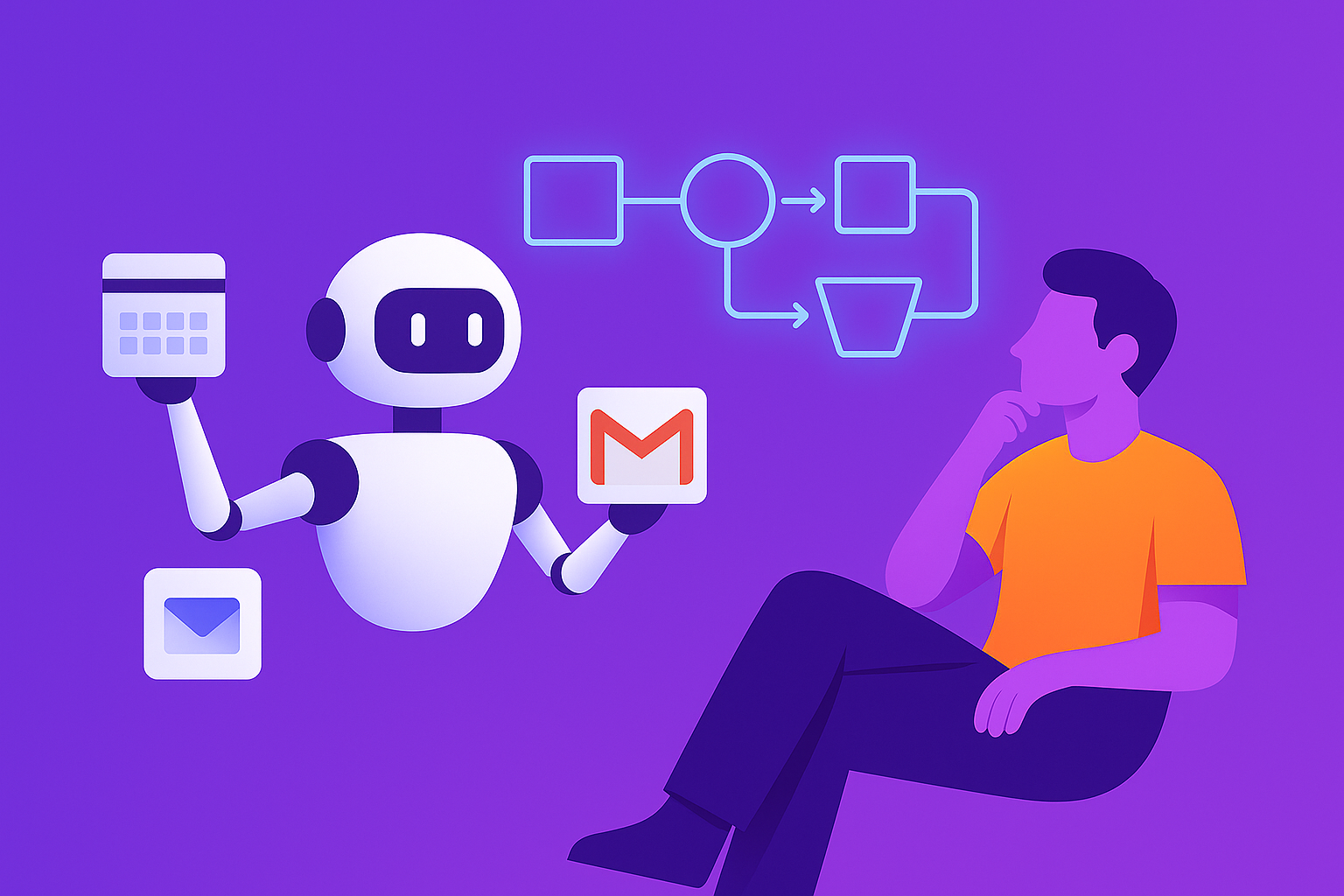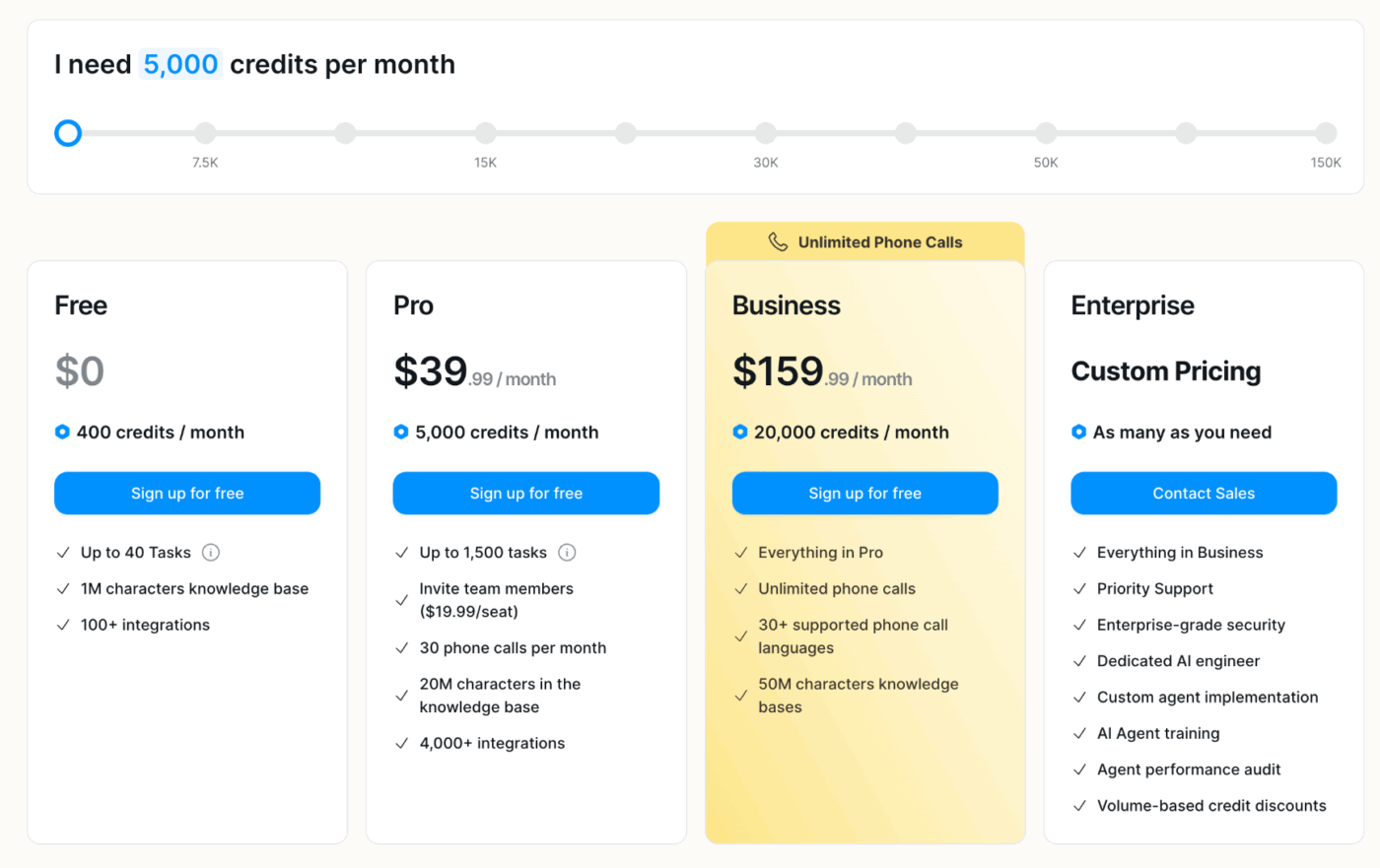What Makes Lindy Agentic AI Different From Zapier or n8n?

Sorry, there were no results found for “”
Sorry, there were no results found for “”
Sorry, there were no results found for “”
Nov 10, 2025
7min read
Yes, Lindy offers agentic AI through its no-code agent platform. Lindy agents automate tasks like email triage, meeting scheduling, and customer support using natural language instructions.
The platform launched in March 2023 and positions its agents as “semi-autonomous,” meaning users define objectives and guardrails while agents handle execution.
This approach prioritizes safety and transparency over fully autonomous behavior, making it suitable for teams managing workflows where control and predictability matter.
When something happens – an email arrives, a form submits, or a meeting ends – the agent activates.
It reads the data and uses Anthropic’s Claude to understand context and decide what to do next. Then it executes by sending emails, updating databases, creating tasks, or triggering other tools.
The platform combines natural language instructions with deep integrations across 1,600+ apps. You describe what you want in plain English using the Agent Builder, and Lindy converts that into an executable workflow. No code required.
The agent then runs continuously, handling tasks in parallel, which means it can research multiple web pages simultaneously, draft dozens of email responses at once, or qualify hundreds of leads while you sleep.
Built-in guardrails include approval steps, audit trails, and fallback logic to ensure agents stay within boundaries while operating autonomously.
The best part is that you don’t need to pick between “simple but rigid” (like Zapier) and “flexible but code-heavy” (like n8n).
Lindy aims for a middle ground: smart enough to reason about data, simple enough for non-technical users to build.
The workflow’s power lies in parallelization. A Lindy agent can research multiple web pages at once, draft follow-ups for dozens of emails in parallel, or qualify hundreds of leads in the time a person handles a handful.
This speed advantage compounds when agents run overnight or during weekends.
Consider Interlaced, an IT services firm with a growth team stretched thin on sales operations. They had a backlog of meeting notes scattered across email and calendar apps, with no clean summary in their CRM. Manual logging was eating four to five hours weekly per person.
Their team deployed a Lindy sales ops agent in under one week without writing code. The agent now:
The result: 5+ hours saved per week on manual data entry and cleaner CRM records. Their CEO noted it was the first solution that turned raw meeting transcripts into structured CRM updates seamlessly.
This example hints at a key competitive distinction: Lindy excels at tasks that require both reasoning and integration. If you need to “read an email, decide what it means, and then update three systems,” Lindy handles that with minimal setup.
Specialized tools like outbound SDRs might beat it on raw lead volume, but Lindy offers breadth you can’t get elsewhere.
Lindy’s positioning emphasizes “AI-native” workflow automation. Unlike Zapier’s condition-based IFTTT logic (“if X, then Y”), Lindy agents use Claude’s reasoning to handle ambiguity
For example, a Zapier automation might check if an email contains “urgent” to route it. A Lindy agent reads the email, understands context and tone, and decides urgency based on actual content.
Community feedback validates this strength for agent-style tasks while surfacing trade-offs:
Strengths:
Trade-offs:
One early user noted that Lindy “mostly just works” for typical office automation but felt “general-purpose” compared to dedicated outbound prospecting tools.
Another praised its flexibility but cautioned that monitoring credit usage on complex loops is important to avoid runaway costs.
The differentiation boils down to this: if your workflow is 70% reasoning and integration, Lindy is likely your best fit. If it’s 90% raw API calls or 100% specialized (e.g., dedicated lead generation), you might reach for a different tool.
Lindy connects to the tools your team already uses. The platform supports 1,600+ apps via 7,000+ pre-built integrations powered by a Pipedream partnership. This means most common SaaS tools are reachable without custom coding.
| Platform | Integration Type |
|---|---|
| Gmail, Google Calendar, Google Sheets | Native connectors for email, scheduling, and data storage. |
| Slack | Send alerts, post summaries, trigger agents from channel commands. |
| Salesforce, HubSpot | Log activities, update deals, pull contact data. |
| Stripe, PayPal | Retrieve transaction data, trigger on payments. |
| OpenAI, Anthropic | Extend agents with custom LLM calls if needed. |
| Web APIs (via Autopilot) | Lindy can click, type, and scrape any web app beyond API limits. |
Beyond pre-built connectors, Lindy supports API calls and webhooks for proprietary or internal systems. The Agents Hub and Community forum also let teams share proven agents, and partner agencies (like Seven Zero Ventures) build and resell Lindy solutions to extend its reach.
This ecosystem positioning means Lindy doesn’t try to replace your entire stack—it ties the pieces together intelligently and automates the glue work between them.
Users generally report strong satisfaction with Lindy’s ease of use and efficiency gains, though feedback reveals nuances worth noting.
“For many, Lindy AI gives the ability to automate typical office tasks in a way that’s not too complicated but also practical. Mostly just works; seems to fall over less than others,” one early adopter noted.
They did flag that Lindy is “hyper reliant” on Google services (it requests Gmail, Calendar, and Docs permissions upfront) and sometimes takes ~20 seconds to initialize a new task.
On Reddit’s r/SaaS, a user shared: “Lindy’s cool but felt kinda general-purpose for me.” They found dedicated tools found more leads for strict outbound prospecting, whereas Lindy provided broader, jack-of-all-trades automation for orchestrating emails and follow-ups without specialized focus.
Best AI SDR for outbound that actually work? (considering Lindy) but would like to know alternatives
byu/Life-Hacking inSaaS
In no-code builder discussions, Lindy earned praise as “more AI-native but still early in ecosystem maturity,” excelling at agent-style tasks while lagging pure API-based automation compared to n8n.
Power users noted that Zapier “just works” for simple flows and n8n offers deep control, whereas Lindy shines in use cases requiring intelligence and multi-step reasoning.
Creative community members have shared hacks, from automating Reddit posts to orchestrating multi-agent workflows.
One popular tip: use Lindy’s “Autopilot” mode for web actions, letting an agent act like a human clicking and typing on any web app. This has enabled cross-posting content between platforms and pulling data from dashboards without APIs.
Others caution monitoring credit usage on complex loops, praising Lindy’s reminders when a flow might become expensive.
Lindy’s trajectory shows ambition beyond simple task automation. Key recent milestones signal the company’s direction:
Mar 28, 2025 – Mobile App Launch
Lindy introduced iOS and Android apps, bringing “AI employees in your pocket.” This update (a top user request) lets teams interact with agents on the go—voice-commanding Lindy to schedule meetings or summarize content from a phone. Real-time notifications keep users looped in as agents complete tasks.
Aug 4, 2025 – Lindy 3.0 Released
A major platform update introduced the Agent Builder (natural language prompt-to-agent creation), Autopilot (agents using cloud computers to perform actions beyond API limits), and Team Accounts (multi-user collaboration and central management). Lindy 3.0 marked a step closer to the vision of fully capable AI employees working alongside human teams.
Aug 27, 2025 – Lindy Build (App Builder):
Lindy expanded beyond agents into AI-driven software creation. Lindy Build is an AI App Builder that generates entire web applications from a prompt—including frontend, backend, and database—and automatically tests and fixes its own code. This “auto-QA” capability aims to deliver production-ready tools with minimal human intervention.
Oct 3, 2025 – Gaia Voice Agent
Lindy launched Gaia, a next-gen AI voice model for phone calls. Gaia delivers more natural, human-like conversations and faster response times (500ms+ faster than prior solutions). T
his unlocks better customer support bots, AI receptionists, and voice-driven assistants. Early users report smoother call flows and significant cost savings by deflecting calls from human agents.
Looking ahead to 2026 and beyond, Lindy hints at “agent societies” features (allowing complex coordination between multiple AI agents) and deeper enterprise integrations.
The company is on track for 10× ARR growth in 2025 with a lean team and plans to invest in more compliance (SSO/SCIM support) and domain-specific AI skills (e.g., finance agents with accounting knowledge).
Lindy offers a straightforward, usage-based pricing model that scales from free experimentation to enterprise deployment:
A credit equals one task execution or action. Certain complex actions—like long phone calls or large-file analysis—may consume multiple credits. Voice agent usage may be metered separately in higher tiers.

One often-overlooked cost is the underlying integration fees if you’re connecting to premium APIs or services. For example, some webhooks or advanced Salesforce connectors might have their own per-use costs, though Lindy’s pre-built integrations typically handle this transparently.
© 2025 ClickUp